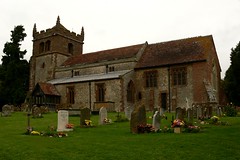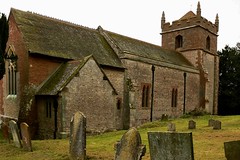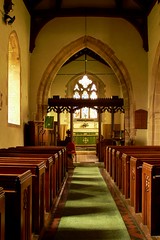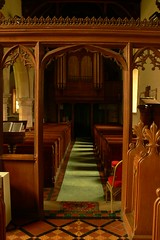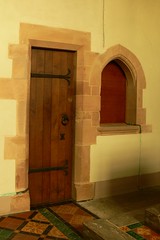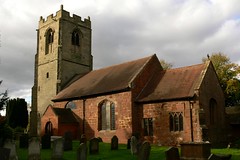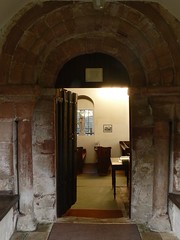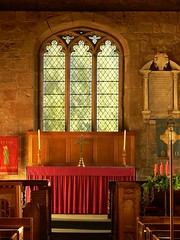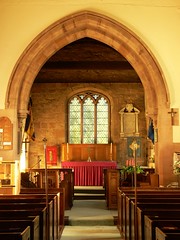Largely rebuilt in 1896 by the architect Bassett Smith in C14 style. Holy Trinity retains some features from C13 particularly the door and bay arches in the south aisle. The tower is C15 and built from Lias Limestone.
A large part of the manor of Churchover was owned by Kennilworth Priory the rents amounting to £4 12s 8d at the time of the Dissolution which was sold to William Dixwell. Other parcels of land were once part of the Combe Abbey estate and after the Dissolution of the Monasteries these reverted to the Duchess of Richmond who then sold the land to the tenant William Dixwell.


The west wall of the south aisle has a large monument to Robert Price (d1595) his wife (Mary), and her parents (Humphrey and Ann Dixwell). The two couples are kneeling and facing each other with their children underneath.



In a similar style to the earlier monument in the south aisle, this monumnet in the north aisle is dedicated to monument to Charles Dixwell (d1591) and his wife Abigail (d1635) and their four children William. Edgar, Humphrey, Basil, and Barbara. The style is very similar to the moment in the north aisle dedicated to Robert Price. It also consists of a couple kneeling, with their children below.

One family member John Dixwell the younger son of Edward (Edgar?) Dixwell, was raised by his uncle Basil Dixwell of Brome Kent. John became a lawyer and joined the Kent county committee and was a captain in the Kent militia. In 1646 he was elected to the Long Parliament as MP for Dover. In 1649 he was one of the 59 signatories of King Charles’s Death Warrant. Following the Restoration of the Monarchy, John Dixwell, fled to New Haven Conneticut where he lived under the name of James Davids.



The font is C12 an inverted cone with roll-moulding on the bottom edge, the cover is Jacobean and dated 1675. The east window is dated 1918 by Arild Rosenkrantz.





St. Nicholas parish church has a Decorated style (C14) west tower, the remainder of the church is in the Perpendicular style of the mid C15. The chancel was rebuilt in the early C19 and is of brick rendered in cement to imitate limestone ashlar blocks.


The red sandstone font is from the early C13, cauldron shaped with carvings of two green men and foilage.
The tower arch has inner half-round shafts and half-octagon capitals. The electric clock in the tower was installed in 1947 as a memorial to those that died in the second world war. The south east aisle window was installed in 1919 by the village at a cost of £100. It is a first world war memorial and “Thanksgiving for Victory”, dedicated to the memory of Howard Drinkwater and William Hakesley.
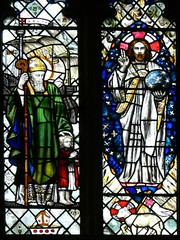


The three light Arts and Crafts east window, by Caroline Townshend, contains an image of St. Nicholas, the central light is a “Salvator Mundi”. The other light has an image of Mary Magdalene, the village previously being owned by Magdalen College Oxford.
The north aisle has two memorials the first is to to George Watson (d1674). The inscription reads:
In the coast of Guiney George Watson son of Thomas Watson of Willoughby (and one of his Majesstes Captains at sea) departed this life July ye 15 anno D. 1674 aetatis suae 45 and gave to ye poor of Willoughby ye profit of £50 for ever to be distributed as by a decree in Chancery is sett forth.
Death hath contrould a Captain bold Yet loss of life is gain Especially when charity For ever doth remaine.
The Willoughby charity was founded in 1437 by Margaret Hayward by a grant of land worth £20. In addition the charity was endowed by William Flavell (1496) and John Brooke (1536). This bequests were added to by George Watson (1647) and Bridget Freemantle (1773). By 1812 the income from the charity was £515 a year.
The second memorial is to Thomas Clerke (d1687), and his wife(d1669). Behind the organ is a table tomb dedicated to another Thomas Clerke (d1663). The tomb itself is mostly obscured by the organ works.
Due to the small population of the parish St. Peter’s has been closed and reopened a number of times during the last 150 years. It finally ceased to hold any regular services in the 1950s.
Nowadays it is owned by the Churches Conservation Trust, and remains a consecrated building, although services are only held here once a year.
The church originally served the nearby medieval village which was abandoned some time during the 14th century. The church continued to serve the villages of Flecknoe, Sawbridge, and Nethercote. However, a smaller church was built in the late 19th century in the village of Flecknoe which is about 2-3 miles away as the crow files. The building was paid for by the railway company in 1891 as compensation for the disruption caused at Wolfhampcote. The railway itself was closed to passengers in 1952 but carried freight until 1963.
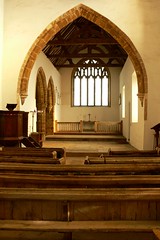
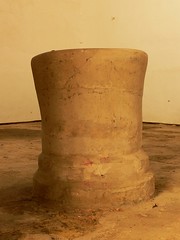
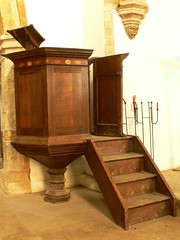
The pews in the foreground are medieval as can be seen by the low shelf which is for resting elbows, not books. The date of these pews is thought to be 14th century but there is some evidence for an earlier 11th century date. The font is Anglo-Saxon. The octagonal pulpit with inlaid panels is dated 1790.
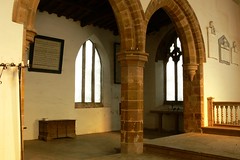
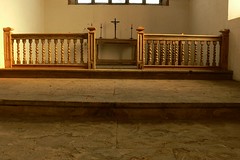
The chancel contains a modern pointed traceried five-light window, and the altar rails are also modern. The floor is paved with a number of memorial slabs from the 18th century, and the walls contain 19th century memorials to the Tibbits family.
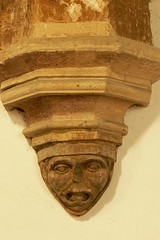
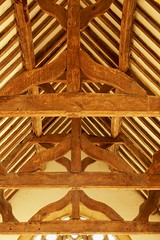
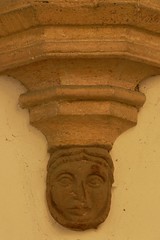
On either side of the chancel arch are half-round moulded corbels. The steep-pitched king-post roof in the chancel consisting of three trusses, and is probably 14th century.
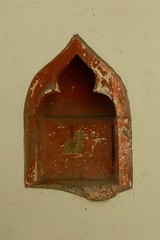
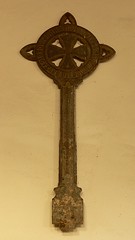
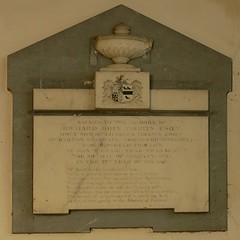
A C14 ogee-headed piscina with circular basin is inset into the south wall of the north chapel, indicating that an altar was once there. The north aisle has a memorial cross to John Truslove who died aged 16.
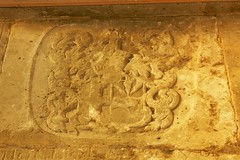
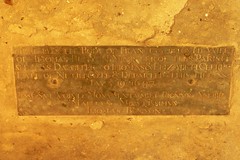
The sanctuary contains memorial slabs and a brass memorial to Frances Benyon wife of parish minister (died 1687).
Built of red sandstone in the 11th century, the tower was added in the 15th. St Leonard’s is one of the counties oldest Norman churches in Warwickshire. The land was given to the Coventry Priory in 1043 by Lord Leofric (him of Lady Godiva fame) mainly woodland from what I can gather it was worth at that time 100s, but by 1086 the monks had chopped a good part of it down and it was only worth 60s. A small part of the ancient woodland it still survives though.
An 11th century Norman semi-circular arched doorway remains as the south entrance. The east wall was rebuilt possible in the 15th century of red sandstone.
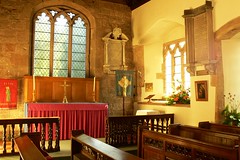
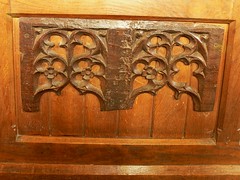
The turned oak balustrade altar rails are 17th century and the front of the benches has late 15th century carved tracery-headed panels.
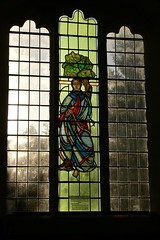
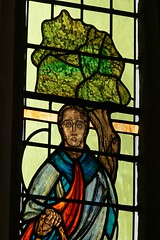
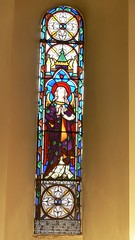
The church contains a modern window celebrating the 100th birthday of Florence Mabel Such, and the lives of Brian Frank Howkins, Katherine Mary Mann, Sally Ann Parke, and Dorothy Clarice Smith. And a Victorian memorial window to Anna Latty, the wife of a previous curate, which is set into a 12th century lancet window.

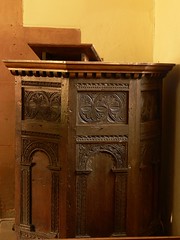
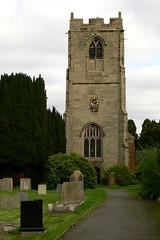
The octagonal font is 12th century, whilst the pulpit is made of 17th century carved panels. The tower is a 15th century addition and its size indicates that the intent was to enlarge the body of the church at that time too.
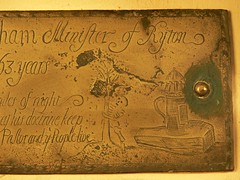
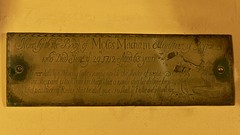
The south wall of the chancel features a small brass plaque with an inscription to Moses Macham, minister of Ryton. who died 29th June 1712.
Lo here doth ly a shining light
wrapped up in the shades of night
the sheppard is took from his sheep
but O would they his doctrine keep
and practice the rules that he did give
So shall ye Pastor and ye People live.
to the right of the inscription is an engraving showing a lantern standing on a coffin and a skeleton holding on to a tree.
Website.






































